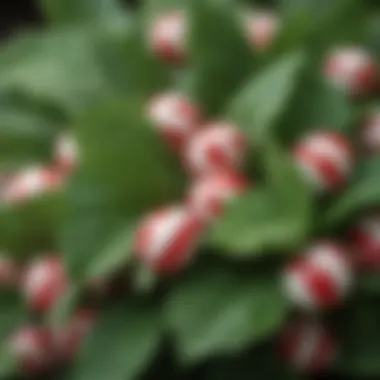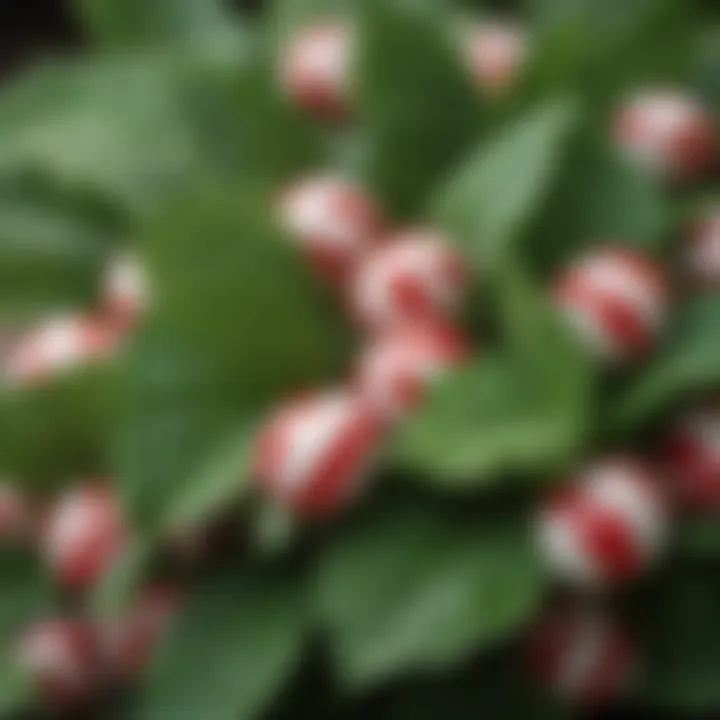Peppermint as a Natural Mouse Deterrent: Effectiveness


Intro
When it comes to tackling a rodent problem in the house, homeowners often find themselves in a bind. Mice can be more than just a passing nuisance; they can wreak havoc on your home and health, gnawing through wiring and spreading diseases. That’s where natural solutions, like peppermint, come into play—offering a potential lifeline to those seeking a gentle yet effective way to deter these uninvited guests.
In this article, we will cover how peppermint might just be the answer in your fight against mice. We’ll dive into the science behind its repellent properties, explore practical strategies for using it, and even consider the limitations that might come with going the all-natural route. Understanding these aspects is critical for those committed to keeping their homes pest-free without resorting to harsh chemicals.
Understanding the Pest
Mice are more than tiny invaders; they are clever creatures well-adapted to survive in human environments. To effectively manage your pest problem, you must first understand these little critters.
Identification
Spotting a mouse can sometimes feel like playing hide and seek. They are primarily nocturnal, often opting to stay hidden during daylight hours. Mice can be identified by their:
- Size: Generally, they are about 2 to 4 inches long (not including the tail).
- Ears: Large and rounded, very distinct.
- Tail: Long and hairless, often as long as their body.
- Droppings: Small, dark, and cylindrical, often found near food sources.
Keeping an eye on these characteristics can help catch a mouse problem early.
Life Cycle
The life cycle of mice is astonishingly rapid, which is part of why they can be so problematic for homeowners. To put it simply, time is not on your side!
- Gestation period: Mice can reproduce as quickly as every three weeks.
- Litter size: A single mouse can produce a litter of up to six to eight pups.
- Survival rate: Under optimal conditions, their population can explode, leading to many mice in just a few months.
This quick reproduction cycle underscores the need for effective prevention strategies; waiting too long can result in an infestation that feels like a full-blown war.
Pest Prevention Strategies
Before mice set up camp in your home, preventative measures can be vital. Understanding various tactics will set you up for success.
Environment Modification
Keeping your home uninviting is key. Rodents are opportunistic creatures, looking for food, shelter, and warmth. Here are some suggestions:
- Seal Entrances: Mice can squeeze through surprisingly small gaps. Close off holes smaller than a quarter with steel wool or caulk.
- Remove Clutter: A tidy home reduces hiding spots. Keep areas like attics and basements organized.
- Store Food Properly: Keeping food in airtight containers prevents access.
Physical Barriers
Sometimes, it might require a little elbow grease and ingenuity to keep pests at bay.
- Using Peppermint Oil: It's not just for freshening breath! A few drops on cotton balls around entry points may signal to mice that your home is off-limits.
- Mice Traps: Combining peppermint with non-lethal traps can also be an effective strategy.
Control Methods
If prevention doesn’t work and you find mice in your home, consider different control methods.
Chemical Control
While peppermint offers a natural approach, some might lean toward commercially available repellents. However, it’s important to read the labels and ensure they're safe for household use, especially if there are pets around.
Biological Control
In some cases, natural predators like cats can help keep rodent populations down. Remember, every method has its pros and cons, and a one-size-fits-all approach rarely works when it comes to pests.
"A moth doesn't need a dictionary to know that it’s moth season. Likewise, mice know when they can find food and shelter. Never underestimate their intuition."
Preface to Natural Pest Control
When it comes to keeping your home free of unwanted guests, natural pest control is gaining traction. This approach emphasizes the use of environmentally friendly solutions that do not rely heavily on chemicals. More and more folks are realizing that methods beyond the traditional sticky traps and poison bait can be just as effective, if not more so, without the potential hazards associated with conventional pesticides. Peppermint, in particular, has garnered attention not just for its refreshingly cool scent, but also for its potential to deter pests, specifically mice.
Understanding Pest Control Methods
In the realm of pest control, methods can typically be divided into three main categories: chemical, biological, and natural. While chemical pest control often delivers a swift solution, it brings risks not only to pests but also to humans and pets that may come into contact with toxic substances. On the flip side, biological methods leverage natural predators or pathogens to keep pest populations in check.
Natural pest control methods, like the use of peppermint, provide a middleground. They offer the benefit of reducing chemical usage while still helping homeowners maintain a pest-free environment. Integrating such methods requires an understanding of the specific pests being dealt with, their behaviors, and the suitable deterrents available.
The Rise of Eco-Friendly Solutions
The tides are turning, as many people rethink their pest control strategies. A couple of factors have driven this shift towards eco-friendly solutions. For one, raised concerns about the effects of chemicals on health and the environment have left consumers feeling wary. Reports about acute poisoning incidents or chronic exposure have left homeowners wondering whether the short-term relief from pests is worth the long-term risks.
Additionally, there’s growing awareness that many conventional pest control tactics can actually create gaps in the natural ecosystem. For instance, indiscriminate use of pesticides can eliminate beneficial insects alongside harmful ones, leading to worse pest problems down the line.


This eco-conscious sentiment is why peppermint, a natural deterrent, is at the forefront of discussions about pest management. By tapping into the plant’s unique properties, many are discovering that they might reclaim their homes while embracing a more sustainable lifestyle. Peppermint is not just a pretty plant; it’s a testament to the effectiveness of nature’s defenses against pesky nuisances.
"Choosing natural pest control methods is not just about removing pests; it's about preserving a balance in our homes and the environment."
Together, these sections create a foundation for exploring the numerous benefits of peppermint in deterring mice and showcase the importance of understanding alternative approaches to pest management. This rush towards eco-friendly solutions reinforces the need for practical, safe, and effective methods—like using peppermint—that are both viable and sustainable.
The Basics of Mice Behavior
Understanding mice behavior is crucial when it comes to implementing effective pest control strategies. Inhabitants of homes often overlook the significance of knowing how these little creatures operate, thinking that simple traps or deterrents will suffice. However, gaining insight into their habits, preferences, and environment can be the key to successful prevention and eradication.
Mice: A Common Household Pest
Mice can be rather invasive little nuisances. They are not just adorable in cartoons; in reality, they are one of the most common household pests. Homeowners often find themselves sharing their living spaces with these rodents, primarily due to a few favorable conditions that homes unknowingly provide.
Mice are particularly adaptive and resourceful, able to squeeze through tiny openings and thrive in almost any environment. They seek food, shelter, and warmth, making kitchens and basements prime real estate. In fact, a household can quickly become an attractive abode for mice if it offers the basics—like crumbs left on the floor or cluttered spaces that provide hiding spots.
Moreover, the reproductive capabilities of mice are astounding. Female mice can give birth as many as ten times a year, each litter containing between six to twelve pups. It’s easy to see how a few initial intrusions can escalate into a full-blown infestation.
Behavioral Patterns and Habitats
Understanding the behavioral patterns of mice is like getting a backstage pass to their lives. These rodents are primarily nocturnal, which means they do most of their foraging and exploring when the lights go out. They have a keen sense of smell and are repelled by certain strong scents, making their attraction to peppermint worth considering.
Mice are also social creatures. They often create pathways through their environments, traveling the same routes repeatedly. Their build-up of familiar trails can be detrimental to homeowners. Once they establish a path, it becomes easier for them to navigate, increasing the likelihood of further infestations.
Preferred habitats of these rodents typically include:
- Nesting Areas: Warm and secluded regions, often in insulation, wall voids, or cluttered spaces.
- Food Sources: Closely situated to human activity, where food might be readily accessible.
- Water Sources: Any moisture-rich areas, such as kitchens and bathrooms, can also attract mice.
By recognizing these patterns, homeowners can better anticipate potential entry points and food sources, allowing for more targeted efforts in using deterrents like peppermint.
"A thorough understanding of mice behavior is half the battle won in effective pest control."
In summary, comprehending mice behavior not only helps homeowners defend their property but also empowers them to utilize natural deterrents alongside traditional methods. By weaving together a strategy that acknowledges the characteristics and habits of these persistent pests, one can enhance the efficacy of measures taken to keep mice at bay.
Peppermint: A Plant with Potential
Peppermint stands out as more than just a flavoring agent for teas or candies; it's a veritable powerhouse in the realm of natural pest control. Its potential to deter mice is of growing interest, especially for those looking to maintain a pest-free home without resorting to harsh chemicals. Understanding what makes peppermint effective goes beyond its pleasant aroma—it encompasses its unique chemical breakdown and historical uses that underscore its role in managing household pests.
Chemical Composition of Peppermint
The efficacy of peppermint fundamentally ties to its volatile compounds, particularly menthol, menthone, and several other terpenes. These components not only impart the signature minty scent but also create an environment unwelcoming to rodents.
- Menthol: Known for its sharp fragrance, menthol contributes significantly to peppermint's pungency. Mice possess a keen sense of smell, and disrupting this sensitivity can lead them to flee. The strong scent acts as a natural repellent.
- Menthone: This aromatic compound offers additional repellent qualities, enhancing peppermint's overall effectiveness.
- Terpene Content: Various terpenes present in peppermint assist in breaking down scents within a mouse’s olfactory system, further establishing peppermint as an unfriendly territory.
Beyond individual components, it’s worth noting how the blend of these chemicals interacts with the environment, making peppermint an attractive option for homeowners.
Historical Use of Peppermint
Peppermint’s journey as a pest deterring agent is woven through history, with its attributes recognized since ancient times. Sources indicate that peppermint has been utilized in various cultures for numerous purposes, from culinary delights to medicinal remedies.
- In ancient Egypt, the sweet scent of peppermint was used in embalming practices, highlighting its significance beyond culinary uses.
- Roman societies employed peppermint not only for seasoning but also for its claimed ability to ward off unwanted pests in food supplies.
- Fast forward to today, it has transcended its edibility; now, it is lauded not just as an herbal remedy but also as a sustainable solution in pest management.
This history is crucial in understanding why peppermint is worth considering as a deterrent in a modern setting. Its longstanding reputation as a natural resource reflects its adaptability and effectiveness in various applications. Overall, as we integrate insights from the past with the scientific understanding of its chemical properties, peppermint establishes itself as a robust candidate for tackling rodent problems in our homes.
Mechanisms of Mouse Deterrence
Understanding how peppermint acts as a deterrent for mice isn’t just a matter of curiosity; it’s pivotal for homeowners aiming for effective pest control. By grasping these mechanisms, people can leverage peppermint’s natural properties to keep their homes rodent-free. The need for natural solutions is growing, and peppermint offers one promising route.
How Peppermint Affects Mice
When it comes to peppermint, its effectiveness hinges on natural chemicals that produce strong scents. The compound menthol is primarily responsible for this aroma, which is typically found in the essential oil extracted from peppermint leaves. Mice have a highly developed sense of smell, which means they can detect even the faintest odors far more acutely than humans can. Peppermint’s scent can be overwhelming to these little creatures, and this olfactory sensitivity leads to a negative reaction.
For instance, the smell can induce stress or even a flight response, interrupting their natural behaviors like foraging or nesting. As they encounter this persistent scent, it can start to form a mental barrier, making the environment seem hostile. Thus, a homeowner can render their territory less welcoming to mice simply by employing peppermint.
In practical terms, the presence of peppermint can cause them to rethink their usual routes or nesting areas, effectively driving them away. According to anecdotal reports, many users have observed reduced activity around peppermint placements, suggesting that it indeed impacts mice behavior.
The Role of Scent in Pest Aversion
The power of scent in pest aversion cannot be overstated. The olfactory system of mice plays a crucial role in their interaction with their environment. Scent is not just a way to find food; it's integral to social communication, territory marking, and even predator avoidance. This makes peppermint’s pungent aroma a significant player in disrupting this communication.
"Scent can alter the dynamics of pest behavior, acting almost as a repellent shield, intercepting their natural inclinations."


Here are several ways scent contributes to mice deterrence:
- Signal of Danger: The strong scent of peppermint is perceived as a danger signal. Mice often equate intense smells with potential threats in their habitats.
- Fear Induction: When exposed to an overwhelming scent, mice can experience heightened anxiety. This fear can lead them to abandon nests they previously considered safe.
- Disruption of Navigation: Typical scent trails left by mice serve as navigational aids within their environments. Displacing these familiar scent markers with a robust aroma like peppermint can confuse them, pushing them to reconsider their routes.
By harnessing peppermint’s natural fragrance, homeowners can exploit the innate aversion behaviors in mice, cutting off their paths and making their living spaces less appealing. This understanding can help tailor strategies for those looking to use peppermint effectively without resorting to harsh chemicals or inhumane traps.
Implementing Peppermint as a Deterrent
When it comes to tackling the persistent problem of mice in homes, implementing peppermint as a deterrent is not just a quirky suggestion; it holds practical significance. Among the various natural remedies, peppermint stands out for its dual advantages: it’s relatively easy to use and has a pleasing scent for humans, though not for mice. The psychology behind using peppermint relies on its strong aroma, which can disrupt the usual comfort zones that mice seek in human dwellings. Thoroughly understanding how to apply peppermint effectively ensures that homeowners can utilize this natural approach wisely.
Methods of Application
Different methods exist for harnessing the repellent properties of peppermint, and the choice you make can greatly influence its effectiveness and practicality in your home.
Essential Oil
Essential oil of peppermint has garnered attention for its intense aroma and versatility. This concentrated form packs a punch without taking up much space. The standout characteristic of peppermint oil is its high menthol content, which not only provides a strong scent but can also be irritating to mice. Applying drops of peppermint oil on cotton balls and placing these strategically around the house is a simple yet impactful strategy.
However, it's worth noting that essential oil needs frequent reapplication, especially in areas that might get washed or disturbed. This could be seen as a drawback for those looking for a more set-and-forget solution.
Dried Leaves
Dried peppermint leaves present another user-friendly option for homeowners. This method leans on the natural aroma derived from the leaves; while not as potent as essential oils, they still exude a strong scent. Dried leaves are easily accessible and can be placed in small sachets or simply scattered in problem areas. The advantage of dried leaves is that they are typically more cost-effective and sustainable.
On the downside, as the leaves age, their scent will diminish over time, requiring regular replacement to maintain effectiveness.
Peppermint Plants
Growing peppermint plants in and around your home adds a delightful visual element while also serving a functional purpose. Fresh plants not only produce a continuous supply of peppermint scent but can also enhance the environment. Having living plants can be a rewarding way to keep mice at bay.
The key characteristic here is the ongoing release of aroma from the foliage. The freshness is an advantage, but not everyone may enjoy the upkeep that comes with maintaining a living plant. Like any other houseplant, peppermint requires appropriate sunlight and watering, making it a more involved option compared to the other methods.
Placement Strategies
Where you place your chosen peppermint remedy can greatly affect its reliability as a deterrent for mice. Appropriate placement enhances the effectiveness of the scent and maximizes rodent aversion.
Near Entry Points
Positioning peppermint application near entry points like doors and windows effectively targets the most common pathways of mice. The fresh scent acts as a barrier that can deter them before they even consider coming inside. This placement option narrows down potential access areas and establishes an immediate deterrence zone.
One attraction of targeting entry points is that it provides a proactive stance against potential infestations rather than simply reactive measures.
Common Pathways
Mice tend to follow predictable routes, usually along walls and under furniture. Sprinkling peppermint-based products along these common pathways can create an olfactory roadblock. This strategy makes it difficult for rodents to move around unimpeded.
However, it requires some observation to determine the most frequented areas in your home.
Nest Areas
Identifying and targeting areas where mice might nest effectively utilizes peppermint's repellency potential. Placing peppermint in these locations can disrupt their nesting behavior, causing them to think twice about settling in. However, locating these areas can be challenging, since they are often hidden and tucked away.
By taking a well-thought-out approach to implementation and placement, homeowners can optimize their use of peppermint as a deterrent against mice, putting up a subtle yet effective barrier to ensure their living spaces remain comfortable.
Limitations of Peppermint as a Deterrent
Peppermint has carved out a niche as a popular natural approach to warding off mice, but it’s crucial to approach this remedy with caution. While peppermint offers certain advantages, there are limitations that homeowners must consider when incorporating it into their pest control regimen. Understanding these nuances not only enhances the realistic expectations of effectiveness but also aids in crafting a more comprehensive approach to rodent management.
Efficacy Over Time
One significant issue with peppermint as a deterrent is its efficacy over time. Initially, the strong aroma of peppermint can be a powerful deterrent. Mice, known for their keen sense of smell, may flee from areas treated with peppermint oil or dried leaves. However, this effect may dwindle as time passes. The potent scent can dissipate, especially if subjected to environmental exposure. For instance, factors such as humidity, temperature fluctuations, and air circulation can quickly reduce the scent’s intensity, thereby lessening its effectiveness against mice.
Households that rely solely on peppermint might find themselves in a precarious situation. If the peppermint loses its scent, there might be a surge in rodent activity, leading to potential infestations that could have otherwise been avoided. To maintain a viable deterrent effect, homeowners often need to renew treatments periodically, which can be both labor-intensive and financially burdensome.
Environmental Factors Affecting Performance
Environmental factors also play a pivotal role in peppermint's performance as a rodent deterrent. The natural habitat of mice can significantly impact how well peppermint works. For instance, in areas with abundant food sources or nesting materials, mere application of peppermint might not be sufficient to keep these pests at bay.
Certain weather conditions can also impact the efficacy of peppermint. For instance, heavy rainfall can wash away peppermint oil, greatly diminishing its viability. Similarly, hot and dry conditions might cause the scent to dissipate more quickly.
Additionally, the placement of peppermint is critical. A spray or infused oil might be more effective in warmer, enclosed spaces compared to outdoor settings where factors like wind can carry the scent away. Choosing the right spot for application is a balancing act between maximizing scent retention and minimizing external influences.


"A well-placed peppermint strategy can help deter mice, but without considering its limitations, the effort may go to waste."
In summary, while peppermint presents an intriguing option for natural pest control, it's essential to recognize its limitations regarding time and environmental factors. A strategy incorporating these considerations can lead to a more effective pest management approach, ensuring that homeowners stay one step ahead in the ongoing battle against unwanted rodents.
Complementary Pest Control Methods
Understanding the need for multiple strategies in pest control is crucial. While peppermint holds promise as a natural barrier against mice, relying solely on one method might not cut it. Combining peppermint with various complementary methods enhances overall effectiveness, providing homeowners with a more robust defense against rodent incursions. This section dives into key complementary strategies that can lead to better pest management outcomes.
Physical Barriers and Exclusions
Physical barriers act as the first line of defence against mice. Sealing cracks and crevices in walls, floors, and foundations can limit their access into homes. Use materials like steel wool to block entry points. Heavy-duty mesh can work wonders around vents and other openings. Homes can be like open invitations if entry points are left unchecked. The benefits are clear: not only does this reduce the chance of mice entering, but it also enhances the effectiveness of any repellents used inside.
Traps and Baiting Techniques
When it comes to traps, they offer a direct approach for dealing with existing populations. Snap traps and live traps are popular choices for homeowners. Traps can be placed strategically in areas where mice are active, often aided by bait that draws them in, like peanut butter or grains. While peppermint oil can help deter new mice from entering, traps work well for those already inside. The combination of both these methods can lead to a more holistic approach that accounts for both prevention and eradication.
Alternative Natural Deterrents
When considering natural deterrents, several options stand out. These alternatives can complement peppermint's properties, creating a multi-faceted approach to pest control.
Cayenne Pepper
Cayenne pepper is known for its active component capsaicin, which is unappealing to rodents. Its strong scent and spiciness can irritate mice, making it an excellent addition to a pest management plan. Sprinkling cayenne around entry points or mixing it with peppermint oil can escalate repellent effects. However, caution is advised to keep it away from pets and children.
Castor Oil
Castor oil, with its strong scent, is another natural deterrent. When rodents smell it, they often find it uninviting. It can be applied in areas where mice tend to congregate. Its use may also come with its own set of challenges, such as the need for frequent reapplication, especially in damp environments, but its effectiveness makes it worth considering as part of an integrated pest management plan.
Ultrasonic Devices
Ultrasonic devices emit high-frequency sound waves that are said to disturb and deter rodents. The idea is that mice are sensitive to these sounds, making their environment uncomfortable. While they might not directly eliminate rodents, they can supplement the effects of peppermint and other deterrents. However, effectiveness can vary widely based on the specific setting and whether there are barriers obstructing the sound waves.
In summary, combining peppermint with physical barriers, traps, and other natural deterrents creates a well-rounded pest control strategy, addressing both prevention and active intervention.
Assessing Effectiveness and User Feedback
Assessing the effectiveness of peppermint as a deterrent for mice is essential for anyone looking to incorporate natural solutions into their pest control strategies. Understanding user feedback offers invaluable insights into real-world applications, allows identification of practical benefits, and helps clarify any potential drawbacks. This assessment combines lived experiences with scientific research, thus providing a well-rounded view of how peppermint performs in various environments. By evaluating real cases and scientific studies, readers can gain a clearer perspective on whether peppermint can fit into their personal approach to managing rodent issues.
Case Studies and User Experiences
Examining case studies and user experiences sheds light on how peppermint functions under varied circumstances. Many homeowners have turned to peppermint for a range of pest control needs, some with remarkable results. For instance, a family in the suburbs found that placing peppermint essential oil-soaked cotton balls in their attic minimized the number of mice sightings significantly. They reported fewer disturbances and felt more at ease knowing they were using a natural product in their home.
On platforms such as Reddit, numerous individuals have shared their own journeys with peppermint as a mouse deterrent. Opinions vary widely; while some hailed it as a game-changer, others found the effects transient. Some users mentioned having to reapply essential oil every couple of weeks for continued effectiveness.
Here are a few key insights from user experiences:
- Positive Effects: Many users reported an immediate decrease in mouse activity after the application of peppermint products.
- Interval Reapplication: Regularly reapplying peppermint, especially in areas prone to moisture or heavy foot traffic, seems essential to maintain the deterrent effect.
- Mixed Results: Some households, notably those with significant or entrenched mouse problems, found that peppermint served better as a temporary solution rather than a one-stop fix.
Scientific Research on Peppermint Efficacy
Scientific literature also provides a backdrop for understanding peppermint's efficacy as a mouse deterrent. A number of studies have investigated the properties of peppermint oil (Mentha piperita), focusing on its active compounds like menthol, which can disrupt the nasal sensory receptors in mice. This disruption causes discomfort and aversion, leading to the notion that peppermint can function as an effective repellent.
Research highlights include:
- Chemical Analysis: Studies have pinpointed that peppermint oil contains several compounds contributing to its repellent qualities, primarily menthol.
- Behavioral Impact: Experiments conducted with mice exposed to high concentrations of peppermint oil showed a significant withdrawal response compared to a control group.
- Environmental Factors: It’s also noted that the effectiveness can fluctuate based on environmental conditions, such as humidity and temperature, which might influence how long the scent lasts in a given area.
Overall, blending user feedback with scientific inquiry allows for a fuller understanding of peppermint's role in pest control. While many have found it to be a useful tool, it appears more effective when combined with other methods, ensuring a holistic strategy toward managing household pests.
End and Future Directions
Peppermint's role as a natural deterrent against mice brings various elements to the forefront of pest management. Understanding how to effectively utilize this herb can empower homeowners to take a stand against rodent infestations, blending traditional knowledge with modern practices. This section aims to solidify the insights gathered throughout the article and to highlight how peppermint can play a part in integrated pest management strategies.
Recap of Key Findings
Examining the chemical composition of peppermint reveals compounds such as menthol and menthone, which are believed to irritate the nasal passages of mice—making them perceive their environment as hostile.
- Peppermint's efficacy in deterring mice is not merely anecdotal; there are studies that support its repellent properties. Various case studies show that homeowners have found success implementing peppermint oil and dried leaves around their Living spaces.
- Application methods matter. Whether using essential oil, dried leaves, or potted peppermint plants, strategic placement is crucial for maximized results. For instance, keeping peppermint near entry points can prevent mice from even thinking about coming inside.
- Limitations and environmental considerations also surfaced. The scent of peppermint may diminish over time, necessitating regular replacement or reapplication. Furthermore, factors such as humidity and temperature can affect its intensity and effectiveness, suggesting the need for vigilance among users.
This summation showcases that peppermint, while not a one-size-fits-all solution, shows promise as a practical element in a larger pest management plan.
Implications for Pest Management Strategies
The insights gathered from the exploration of peppermint's efficacy encourage a more holistic approach to pest control. Here are some recommendations based on our findings:
- Integrate peppermint with physical barriers: While peppermint can deter mice, securing entry points with physical barriers like steel wool or caulking can enhance overall defense against rodent infiltration.
- Combine natural deterrents: Considering alternative natural methods alongside peppermint, such as cayenne pepper or castor oil, can provide a broader spectrum of protection.
- Frequent monitoring: Homeowners should remain vigilant and adapt their strategies over time. The changing dynamics of pest behavior necessitate an adaptable approach, ensuring that peppermint’s repellent properties remain effective throughout changing seasons.
- Educational tools: Providing resources for homeowners about integrated pest management can empower them to utilize multiple strategies effectively. User experiences and community feedback are invaluable for constructing robust pest solutions.
In summary, the future of pest management that includes peppermint is promising, particularly for homeowners keen on eco-friendly solutions. More empirical research and community engagement may further elucidate peppermint's role in a comprehensive pest control approach.







